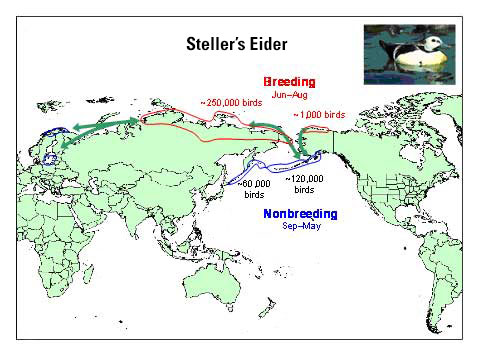Steller's Eider, Polysticta stelleri
High-Priority Species ListPrevious work on virus exposure (not avian influenza) of molting sea-ducks showed substantial variation in prevalence among flocks and locations (Hollmén et al. 2003). Thus, it seems clear that birds within flocks are not independent from the stand point of virus exposure. During the flightless molt, flocks of birds are functionally isolated within lagoons as large areas of unsuitable habitat separate flocks; however, exchange of individuals prior to the molt likely creates a positive correlation in exposure probability within lagoons. Thus, a sampling strategy spread relatively uniformly across the molting range is the most effective sampling strategy for birds molting in clumped distributions.
Sampling locations: Primary locations in order of priority include Nelson Lagoon, Izembek Lagoon, Seal Islands, and Kuskokwim Shoals. Secondary locations, within these lagoons, will be determined based on channel systems and observed flock locations and movement patterns.
Sampling timeframe: Late August through late September.
Sample demographics: After-hatch-year males and females. The sample will be primarily post-breeding males and both failed and non-breeding (likely sub-adult) females.
Methods of capture: Flocks of flightless birds will be herded with boats and driven out of the water into corral traps. This approach has been used to capture >65,000 Steller's Eiders for >20 years.
Other targeted species: None, flocks of eiders rarely mix with other species.
Supplemental sampling: Small numbers of Steller's Eiders can be sampled in conjunction with other ongoing studies. A study of the nesting productivity of Steller's Eiders near Barrow, Alaska finds from 0 to 30 active nests per year. Fecal samples and a small number of cloacal swabs can be obtained in conjunction with this work. Also, several studies of wintering ecology and movements are capturing <30 Steller's Eiders at several different wintering areas. Cloacal swabs will be taken from these live captured birds.
Contact: Julian Fischer/ Tim Bowman
Izembek NWR (Sampling at Izembek and Nelson Lagoons)
Yukon Delta NWR (sampling at Kuskokwim Shoals)
U.S. Geological Survey
Contact: Paul Flint
Flint, P. L., M. R. Petersen, C. P. Dau, J. E. Hines, and J. D. Nichols. 2000. Annual survival and site fidelity of Steller's eiders molting along the Alaska Peninsula. Journal of Wildlife Management. 64:261-268.
Hollmén, T. E., J. C. Franson, P. L. Flint, J. B. Grand, R. B. Lanctot, D. E. Docherty, H. M. Wilson. 2003. An Adenovirus Linked to Mortality and Disease in Long-tailed Ducks (Clangula hyemalis) in Alaska. Avian Diseases 47:1434-1440.
Kertell, K. 1991. Disappearance of the Steller's Eider from the Yukon-Kuskokwim Delta, Alaska. Arctic 44:177-187.

Ranking Score: 15.0
Asian H5N1 ranking criteria for Steller's Eider, Polysticta stelleri.
Total of partial contact with Asia1 |
Contact with known "hot spot"2 |
Habitat used in Asia3 |
Pop. in Alaska4 |
Can samples be obtained? |
Score |
4.0 |
1.0 |
4.0 |
3.0 |
3.0 |
15.0 |
Most (>90%) of the Pacific-wintering population (250,000) breeds in northeastern Asia |
No known use of AI-infected areas |
Uses estuarine and freshwater habitats |
Winter pop. approximately 80,000. Breeding pop. <1,000 |
Rel. easy to trap during fall molting period |

